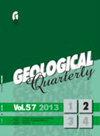Contamination and health risk assessment of potentially toxic elements in soils of different kinds of land use in Lithuania
IF 0.7
4区 地球科学
Q3 GEOLOGY
引用次数: 0
Abstract
Using the case of five different kinds of land use from different territories of Lithuania, this study assesses the level of contamination and human health risk assessment of arsenic (As), and heavy metals (HMs) such as cadmium (Cd), copper (Cu), zinc (Zn) and chromium (Cr) in the surface soil of the study areas. Geo-accumulation index (Igeo) analysis indicated that heavy Cd contamination occurred in agricultural territory (AT), while for As, no contamination to mild contamination occurred in all territories. For living territory (LT), green territory (GT) and technical territory (TT), Igeo readings for Cu showed no pollution to moderate pollution, while there was no pollution for natural territory (NT) and AT. For AT, there is no contamination from Zn or Cr. By contrast, Igeo values for Zn and Cu represent minimal to no pollution in the remaining territories. As in LT and Cd in AT, two of the HMs discovered, were deemed to be of medium risk, whereas other components fell into the permitted range. Among three different routes to exposure, it was discovered that the ingestion pathway was the main health risk. The Hazard quotient (HQ) and hazard index (HI) values for As, Cd, Cu, Zn, and Cr were lower than the suggested limit (HI = 1), indicating minimal non-carcinogenic risk to inhabitants in the study regions. The carcinogenic risk values for As (1.12E-04 children), Cd (2.20E-04 children), and Cr (2.35E-04 children) in AT pose a risk to children’s health when ingested. The GT’s carcinogenic readings for Cr (1.02 E+00 adult), put adults at risk of developing cancer, whereas As (1.89E-04) and Cr (2.28E-04) in LT put children at risk of cancer and for TT, both adults and children were at risk due to Cr’s higher carcinogenic values (1.93E-04 for adults and 5.21E-04 for children).立陶宛不同土地利用方式土壤中潜在有毒元素的污染和健康风险评估
本研究以立陶宛不同领土的五种不同土地利用为例,评估了研究区域表层土壤中砷(As)和镉(Cd)、铜(Cu)、锌(Zn)和铬(Cr)等重金属(HMs)的污染水平和人类健康风险评估。地质累积指数(Igeo)分析表明,农业区(AT)发生重镉污染,而砷(As)在所有地区均未发生污染至轻度污染。在生活区域(LT)、绿色区域(GT)和技术区域(TT), Igeo读数显示Cu没有污染到中度污染,而在自然区域(NT)和技术区域(AT)则没有污染。对于AT,没有Zn或Cr的污染。相比之下,Zn和Cu的Igeo值在其余地区表现为极低或没有污染。与AT中的LT和Cd一样,发现的两种HMs被认为具有中等风险,而其他成分则处于允许范围内。在三种不同的接触途径中,发现摄入途径是主要的健康风险。砷、镉、铜、锌和铬的危害商(HQ)和危害指数(HI)值均低于建议限值(HI = 1),表明研究区域居民的非致癌风险极小。AT中砷(1.12E-04儿童)、镉(2.20E-04儿童)和铬(2.35E-04儿童)的致癌风险值在摄入后对儿童健康构成风险。GT的致癌读数为Cr (1.02 E+00成人),使成人有患癌症的风险,而LT中的As (1.89E-04)和Cr (2.28E-04)使儿童有患癌症的风险,而TT中,由于Cr的致癌值较高(成人为1.93E-04,儿童为5.21E-04),成人和儿童都有患癌症的风险。
本文章由计算机程序翻译,如有差异,请以英文原文为准。
求助全文
约1分钟内获得全文
求助全文
来源期刊

Geological Quarterly
地学-地质学
CiteScore
2.20
自引率
0.00%
发文量
19
审稿时长
>12 weeks
期刊介绍:
The policy of the Geological Quarterly is to publish significant contributions of information and geological insight relevant to an international readership. The journal has been issued since 1957 at the Polish Geological Institute - National Research Institute and, at present, is the leading Earth sciences journal in Poland. All aspects of Earth and related sciences, and universal and broad regional rather than locally oriented topics are covered.
The journal is intended to be an international forum for the exchange of information and ideas, particularly on important geological topics of Central Europe.
 求助内容:
求助内容: 应助结果提醒方式:
应助结果提醒方式:


